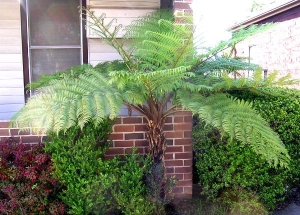The association at the word "fern" is always ambiguous. Someone has something mysterious and mysterious in his mind, someone associates this beautiful plant with lush green foliage, while others immediately have an imaginary composition of rock garden. Fern really is a great addition to the garden compositions. You can adapt it even in the most difficult, at first glance, conditions. This can be done with proper care and selection of the species of the waiic plant.
Content
Types of ferns
Fern grows on earth since the very time when it was inhabited by dinosaurs. From that period to the present, many species of this herbaceous plant have survived.
According to researchers, this figure is more than 10 000. Despite the wide variety of images of this plant, it has one feature: a fern never blooms. About him make up whole legends, but documented so no one recorded the fact of flowering.
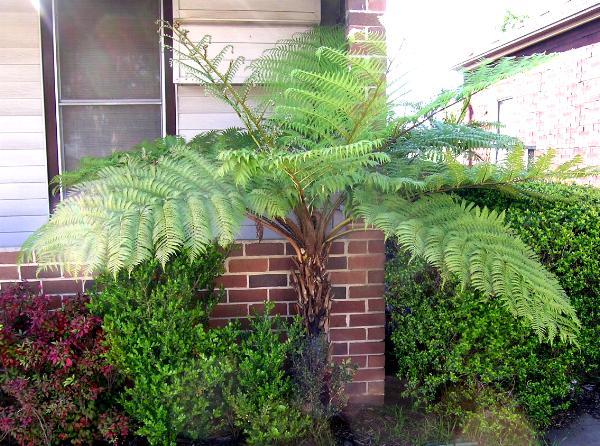
Even considering that the fern does not have a flowering part, it is used for landscape design. Here are some of the popular species of this plant:
- Fern Adiantum - the most suitable for climatic zones of Russia is the fern Adianum Stoppoid and Venin hair. The first subspecies is particularly well established in the Far East, in the forests of the Amur and Primorye. With regard to Venus hair, it feels good in the Crimea and the Caucasus near mountain rivers and reservoirs.
Venus of hair is considered to be one of the most widespread species, which grows well on the territory of a private farm, as well as in natural conditions. Distinguish its openwork cut leaves, which grow on petioles, like a thin wire. Leaves, like tufts, grow from a powerful root stem. Its height does not exceed 0.5-0.7 m. Bottom on the leaves are spore bags, they look like dark spots.
The Adiantum by nature does not like windy areas. The plant develops full life in shaded areas where there is enough moisture. It is only for him to allocate the right place and he will enjoy his appearance for several decades. If very hot days occur, then the fern should be watered. Watering is arranged in a special way - sprinkling. The soil must be slightly acidic and fertilized with organic fertilizers such as humus or compost. The drainage layer is embedded in the base.
With proper care, the fern literally turns into a luxurious globular scrub in a few years. Landscape designers recommend planting it in rockeries, along water reservoirs, in garden compositions, together with an umbilicus or purifier. Some gardeners like to decorate the garden with ferns of this kind right in the pots, not planting in the ground;
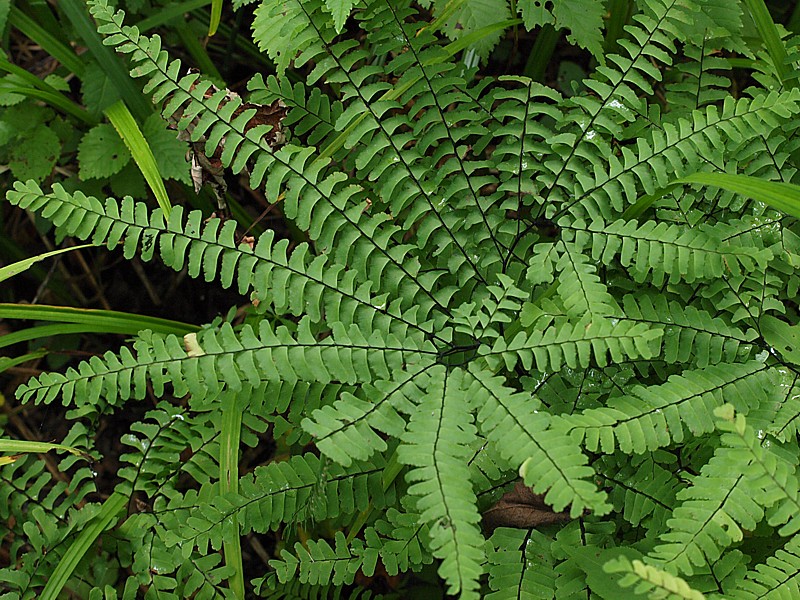
- Fern Shchitovnik male - has a wide variety of subspecies, among which is found:
Austrian Shchitovnik. A favorite place of growth on loamy moist soils. Has triangular leaves with a span of up to 1 m. Color: light green. On the ground a carpet is spread, for which it is called "Spread".
Amursky Shchitovnik - gardeners prefer this plant variety for its high frost resistance. The color is bluish-green, the shape of the leaves resembles feathers. With the onset of frost, triangular vayi die off.
CombShield- one of the most common types of his group. It can grow in any territory of Russia. More suitable for him will be the conditions of moisture. It is good, if there is a pond nearby.
A perennial plant in adulthood reaches no more than 0.5 m. It has a short but thickened rhizome, covered with scales from above. The color of the leaves is close to the dark green. On their opposite side there are black spores arranged in a row. Leaves have an elongated shape. They are attached to erect stalks.
In addition to the above listed species, for Garden beds the Scent Pahuchiy is suitable, which has a pleasant aroma and a miniature size, a decorative view of the Lozhnomysh Shchitovnik, the Sikhotinsky Shchitovnik.
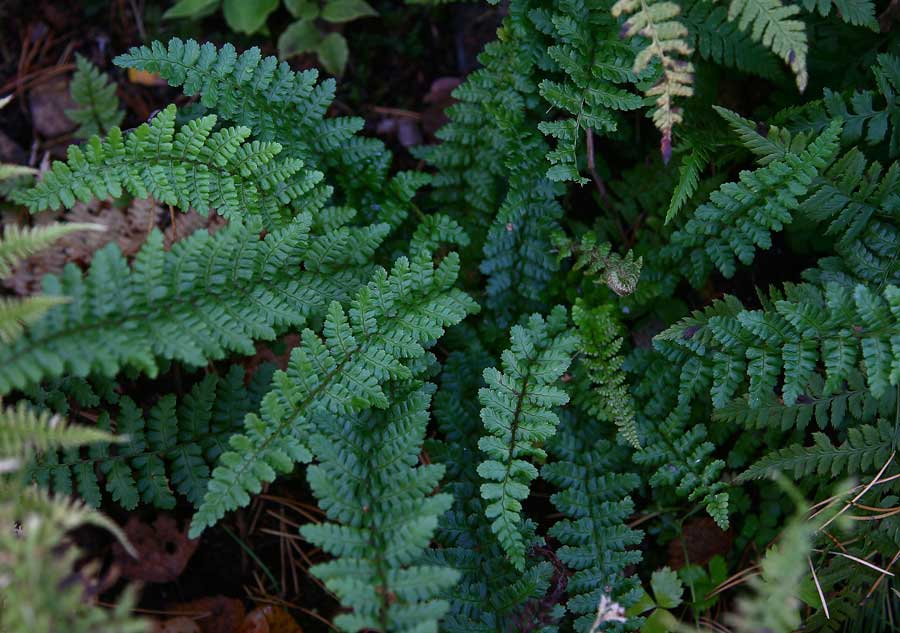
- Ferns of Orlyak - is an unusually useful plant. It is always useful in the household. Many owners of household plots prefer this particular fern. It has an attractive aroma, due to the high content of tannins in it. Due to this property, fern leaves are used to store garden crops. Vegetables, fruits and berries are spread on the leaves of Orlyak, then cover them with crops.
The shape of the branches of the fern Orlyak is lush and sprawling. Leaves are hard, three-pinnate. On height it is no more than 0,5 - 0,6 m. The root is branched, horizontal. The plant is naturally unpretentious and can grow even in the most depleted areas. Below, if you look at the lower pairs of leaves, you can see the nectary. He attracts ants. Spores are on the bottom of the sheet, for additional protection, its edges are twisted;
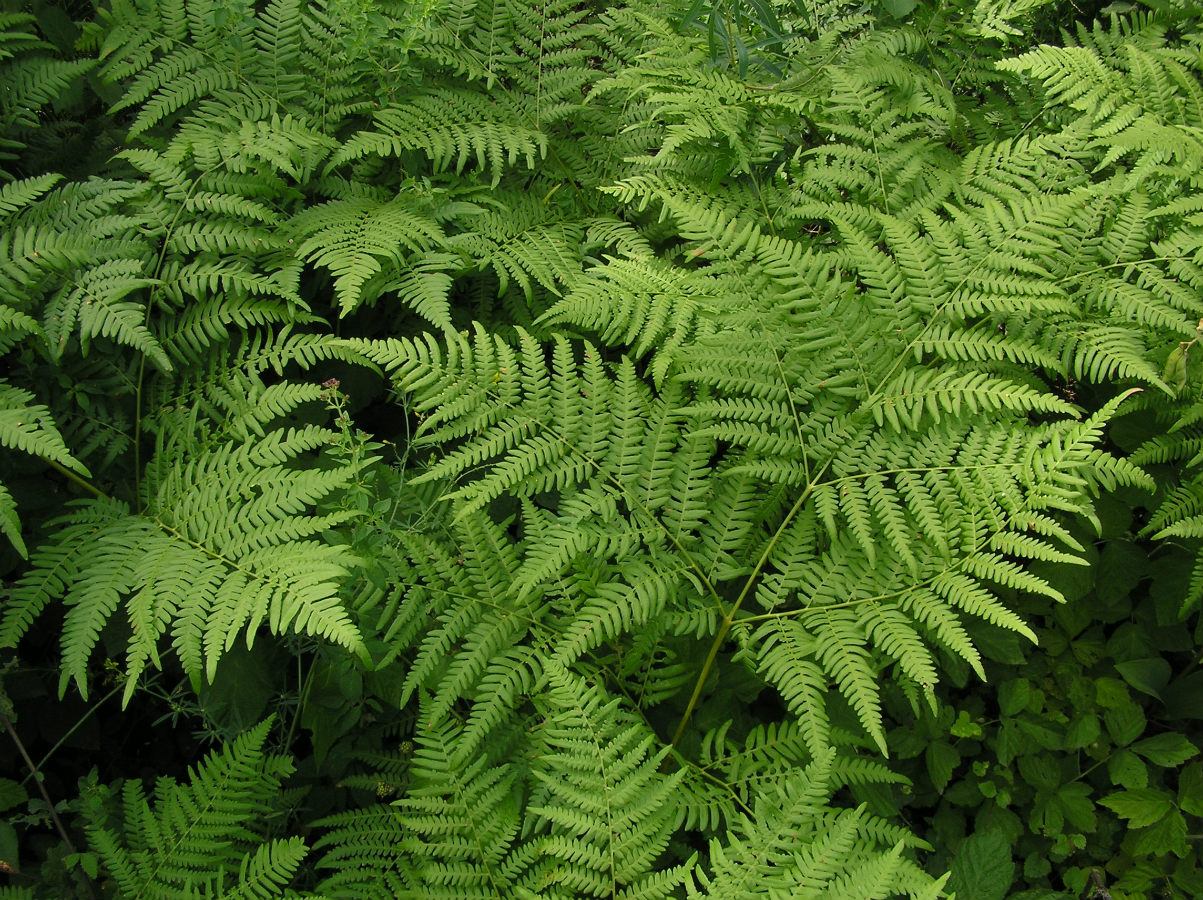
- Fern Ostrich - Vertical upright leaves are characteristic for this species. They are quite dense and can reach a height of 2 m. Circling leaves grow in rows. There are smaller sporophores in the center. On their back part are attached dark spore points. The root system is underground, rapidly developing. Fern Ostrich is of several types: Eastern and Ordinary. Ordinary Straussnik is not afraid of frosts, which can not be said about the East. A fragile plant does not tolerate winds and needs constant moistening.
The fern resembles a bouquet of ostrich feathers, hence its name. Gardeners often grow this species for its decorativeness. The leaves look great in floral arrangements;
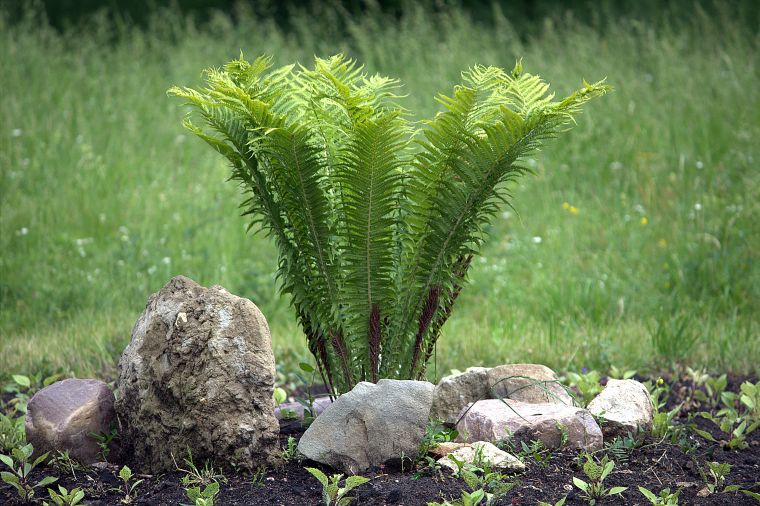
- Kochetyshnik - There are several types: Female, Chinese, Nippon, Burgundy Leyz. All ferns from this subspecies are shade-loving and can grow up to 10-15 years in one place. Soil must be well-groomed and fertilized in advance. The kitten is not afraid of frosts.
The female Kocheydzhnik has green shoots. They are very gentle to the touch and have a pinnate complex shape. The length of the petioles grows to 1 m. The root of the plant is short and thick. The Chinese Kocheydzhnik, like the female, reaches a height of 1 m, but the color of its leaves has an unusual reddish tinge. Nippon plant variety is also the owner of an exotic violet color. Burgundy Leise is shade loving. The darker its habitat, the more intense the wine color of the leaves. It is characterized not only by the reddish color of the foliage, but also by the burgundy color of the petiole.

Fern garden can be selected for any site, both for the darkened and for the site, saturated with sunlight. The same applies to the type of soil. Of the many species, each gardener is able to choose the right one for himself: a fragrance that publishes, is edible, decorative or even curative.
Fern in the garden planting and care
Before planting a fern, you need to know some rules for the care and maintenance of this perennial. If you want to acquire a ready-made plant, it can be excavated in the forest. So you will be sure that it will get accustomed, as it is grown at home latitudes. But there are other ways to grow.
As for the place of fern planting, it should be planted in wide holes, no more than 0.5 m. The part of the land that you need to fill in the hole must be from the place where you took the procession. Transplant the fern immediately, so that the roots do not have time to dry. Otherwise, the plant will not be reanimated. The same should be taken into account in the leaves. The stems should not be faded. You can not separate the earth from the roots, it would be better if you dig the fern in such a way that a clod of earth remains on the rhizome.
Ferns in the garden growing
Fern in the backyard farm can be grown in several ways: by separating the fragment from the rhizome of the tall fern, by budding and by growing from spores.
- Separation of roots the fern is carried out as follows. In the garden, in the forest or on the site where the fern grows, you find a healthy individual. In the adult bush there should be no dried and damaged leaves. At the root divide the rosettes, the separated part within 24 hours transplant to a certain site in the garden. Komja the wood earth try to keep on a maximum that the plant has got accustomed better. For transportation to the house, place the fern root with moss. So moisture remains in the roots.
Plant the plant in a shaded area. At the bottom lay out drainage and a small amount of fertilizer. Ferns can also settle on scanty soils. But watering should be abundant at least the first time after transplantation (7 days);
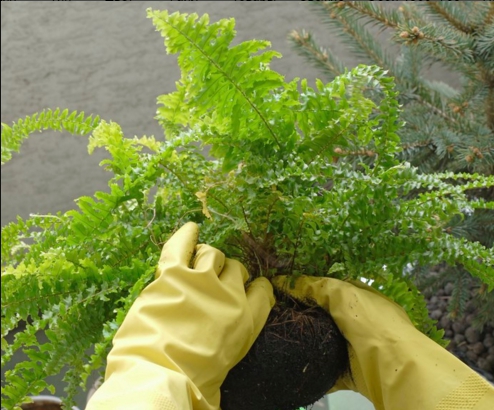
- Pocification Ferns are carried out in autumn or late summer. Approximately at the end of August, find a suitable bush. Developed leaves bend to the ground. Sprinkle this place with soil about 1-1.5 cm. Do not cover the main vein, leave it open.
With the advent of spring, several new sprouts will grow on the site of the buried shoot. They will need to be separated from the twigs and transplanted into the garden;
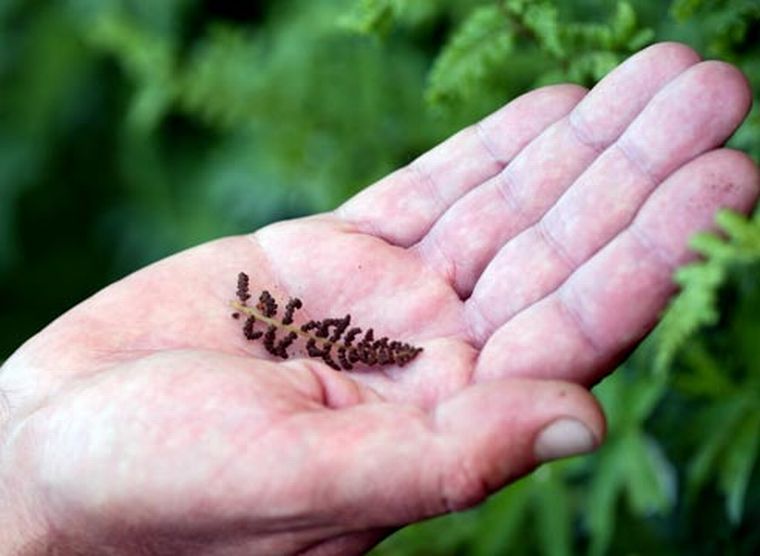
- Fern Seedsare collected in several ways. The first option: break off the sheet with spores on the reverse side. Put it in a paper bag or on a lighted window sill until the shoot runs out. As soon as the leaves dry, you can collect spores and put them in a bowl.
The second option: take a knife, flip the leaf of a living plant and scrape the sporebags into a box, a sheet of newspaper or some container. Then dry the seeds and land in a container filled with earth (part of the forest land and part of the universal or garden soil). Seeds are sown over the soil and watered from the spray tank. Rain watering will spur growth. Then there will be insemination, and only then will begin to appear small appendages. This occurs usually on day 25 after planting a dispute. By spring, the prepared fern is replaced by a permanent fern.
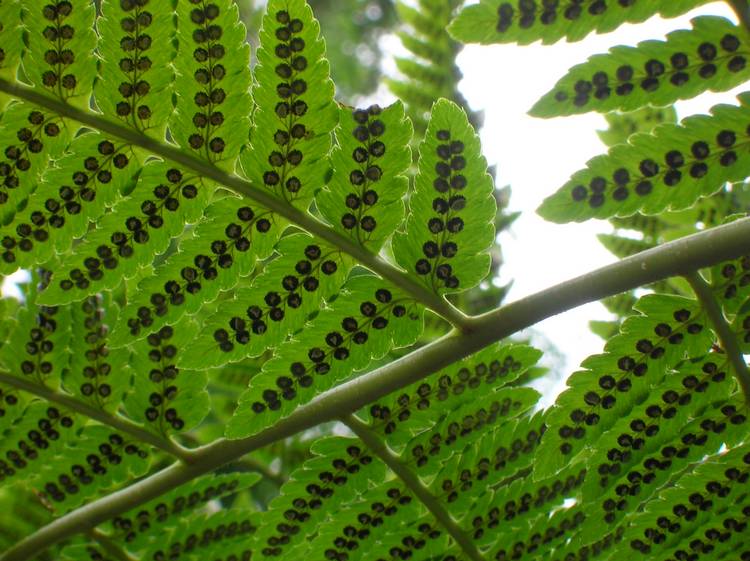
Planting a fern in the garden
- The plant should be planted in the spring. To plant the fern in the horticultural area is chosen a shaded location. As an exception, plants can be planted and sunny area, only to do it stands with such species as the Woman and the Male Shield Male. After transplantation for these fern groups it will be necessary to provide timely abundant watering so that the plant can comfortably develop;
- The depth of the hole should be no less than the clod of earth with which you transplant the plant. Add a drainage layer and a certain amount of fertilizer to expedite the collection of phytomass;
- As a fertilizer during transplantation, you can use three equal parts of compost, sand and peat (humus). Further, the use of a universal fertilizer for garden plants is allowed. Top dressing should be done once a month from May to July. Can often, but no more than 1 time in three weeks;
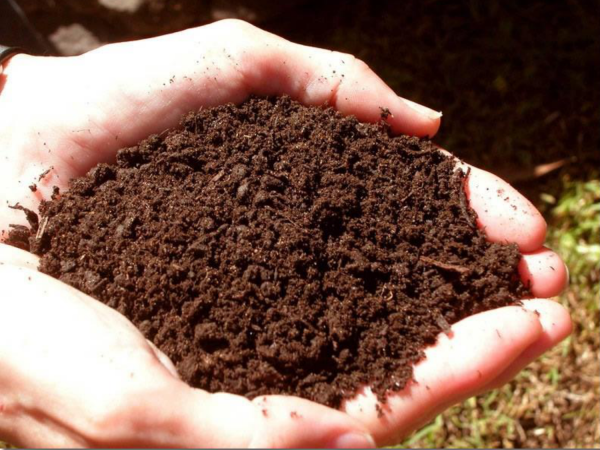
- The soil of the fern should be moistened. Especially this fact should be taken into account the first week after the transplantation of the forest plant. Make sure that the plant does not "float". The overabundance is disastrous for the developing root system. As you grow, also try to keep the soil hydrated;
- The listed species of ferns tolerate frosts and colds well. But the Kochetyshnik requires additional care. For the winter it needs to be covered. It is allowed to use fallen leaves, peat, spruce branches.
Why the fern dries in the garden
Despite the fact that the fern is a perennial plant, any disease can lead to its withering, and, as a result, its death.
One of the most common cases of fern extinction is the gradual drying of the plant. It can happen for the following reasons:
- The wrong content of the plant. Fern loves shade, only some varieties are capable of perceiving the sun's rays. Perhaps, it is this fact that affects the drying of the stems. You can fix this by replanting the plant. Insufficient intake of moisture can also affect the drying of the leaves. Before planting it is recommended to prepare a drainage layer;
- Incorrect watering. In the first week after landing in the garden, the fern should be watered abundantly. If it is poured with water, the leaves may turn yellow. If the fern grows in a shaded garden area, but the air is very dry, then it should also be watered additionally. For irrigation it is necessary to use water without chlorine and lime;
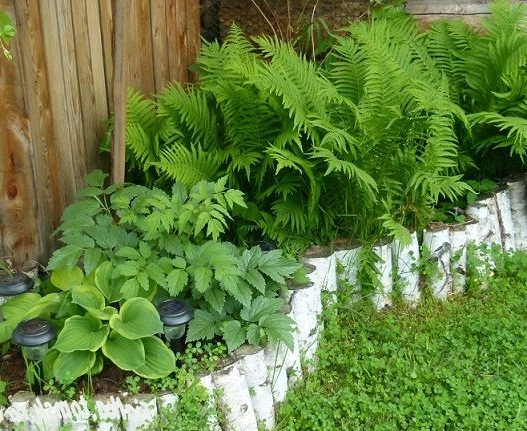
- Pests. Shield Fern, Fern aphidcan damage the plant. In the beginning, the leaves shrivel, then fall off. In order to avoid the death of the plant, it is necessary to periodically inspect the fern sheets and in case of detection of pests treat them with a soap solution (laundry soap mixed with water). Mealybugalso leads to the death of the plant. If found, moisten the tampon in alcohol solution and wipe off the parasite from the leaf. In advanced cases, treat the plant with carbophos. Leaf nematodes affect the plant no less than the above insects. In the beginning, the leaves turn red, then dry out. To prevent the death of the fern, use the emulsion of heterophos.
Choose the time to periodically inspect all the plants on your site. This can prolong their life and the splendor of your garden. Observing these simple tips along with the rules for planting and reproduction, you will admire the forest plant on your site for a decade or so.


